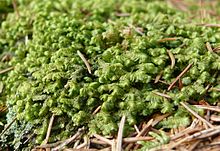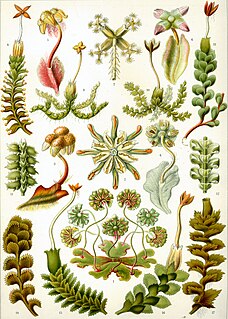
The Marchantiophyta are a division of non-vascular land plants commonly referred to as hepatics or liverworts. Like mosses and hornworts, they have a gametophyte-dominant life cycle, in which cells of the plant carry only a single set of genetic information.
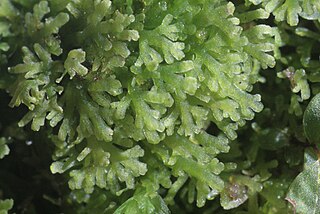
Metzgeriales is an order of liverworts. The group is sometimes called the simple thalloid liverworts: "thalloid" because the members lack structures resembling stems or leaves, and "simple" because their tissues are thin and relatively undifferentiated. All species in the order have a small gametophyte stage and a smaller, relatively short-lived, spore-bearing stage. Although these plants are almost entirely restricted to regions with high humidity or readily available moisture, the group as a whole is widely distributed, and occurs on every continent except Antarctica.

Lepidoziaceae is a family of leafy liverworts. It is a group of small plants that are widely distributed.

Bryology is the branch of botany concerned with the scientific study of bryophytes. Bryologists are people who have an active interest in observing, recording, classifying or researching bryophytes. The field is often studied along with lichenology due to the similar appearance and ecological niche of the two organisms, even though bryophytes and lichens are not classified in the same kingdom.
Herbertus borealis is a species of liverwort in the family Herbertaceae known as northern prongwort. It was described in 1970 by Alan Crundwell. It is endemic to Scotland, where it is found only in the Beinn Eighe nature reserve, and lives in dwarf shrub heath alongside other large liverworts such as Anastrophyllum donnianum, Bazzania tricrenata and Pleurozia purpurea. A closely related species, described in 2012 as Herbertus norenus and known as "Viking prongwort", is known from Shetland and Norway and was formerly confused with H. borealis.

Radula is a genus of liverwort, and is the only genus in family Radulaceae.
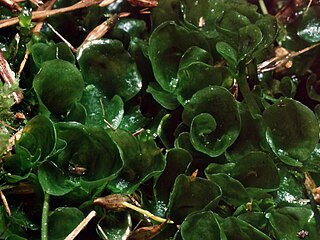
Phyllothallia is a small genus of liverworts of the Southern Hemisphere. It is classified in the order Pallaviciniales and is the only member of the family Phyllothalliaceae within that order. Unlike most members of the Metzgeriales, Phyllothallia has a leafy appearance. The genus has a disjunct distribution, with the species Phyllothallia nivicola found in New Zealand while the other species in the genus, Phyllothallia fuegiana, occurs in Tierra del Fuego.

Pellia epiphylla is a species of thallose liverwort. It occurs in North America, Europe, North Africa and parts of Asia. It grows in patches in damp, sheltered places on neutral or acidic substrates. It is common on the banks of rivers, streams and ditches and also grows in wet woodland, marshes and on wet rocks.

Ptilidium is a genus of liverwort, and is the only genus in family Ptilidiaceae. It includes only three species: Ptilidium californicum, Ptilidium ciliare, and Ptilidium pulcherrimum. The genus is distributed throughout the arctic and subarctic, with disjunct populations in New Zealand and Tierra del Fuego. Molecular analysis suggests that the genus has few close relatives and diverged from other leafy liverworts early in their evolution.

Epimartyria auricrinella is a species of moth belonging to the family Micropterigidae. It was described by Lord Walsingham. It is known from the eastern parts of the United States as well as south-eastern Canada.

Bartramia pomiformis, the common apple-moss, is a species of moss in the Bartramiaceae family. It is typically green or glaucous in hue, although sometimes it can appear yellowish. The stems extend from a half cm to 8 cm, with narrowly lanceolate to linear-lanceolate leaves 4 - 9 mm long. The leaves have a nerve and are toothed. They are curled when dry but stick out when moist.

Polytrichum juniperinum, commonly known as juniper haircap or juniper polytrichum moss, is an evergreen and perennial species of moss that is widely distributed, growing on every continent including Antarctica.
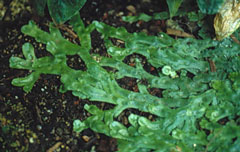
Conocephalum conicum, the great scented liverwort, common mushroom-headed liverwort or snakeskin liverwort, is a liverwort species in the genus Conocephalum .

Ptilidium ciliare is a liverwort with the common names ciliated fringewort and northern naugehyde liverwort. It is widespread in Canada, Alaska, the northeastern United States, Greenland, Iceland, and northern Europe occasionally as far south as northern Italy.

Mylia taylorii, or Taylor's flapwort, is a species of leafy liverwort.

Sphagnum fimbriatum, the fringed bogmoss, is a slender Sphagnum moss.

Rhizomnium punctatum, also called dotted thyme-moss, is a small species in the genus Rhizomnium.

Cyathophorum bulbosum, commonly known as quill moss or the false fern moss, is found in the eastern states of Australia as well as Papua New Guinea, New Zealand, Auckland Islands, Chatham Island, Lord Howe Island and possibly Norfolk Island and New Ireland.

Marchesinia mackaii, or MacKay's pouncewort, is a species of leafy liverwort.

Northpark Copse to Snapelands Copse is a 101.4-hectare (251-acre) biological Site of Special Scientific Interest north of Midhurst in West Sussex.
